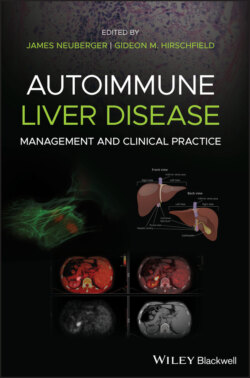Читать книгу Autoimmune Liver Disease - Группа авторов - Страница 47
Adaptive Immunity and Adaptive Immune Functions of the Liver
ОглавлениеAs shown in Figure 2.2, the adaptive immune system in autoimmunity generates multiple, delayed, autoantigen‐specific effector immune responses [4]. Most adaptive immune responses occur in lymph nodes and spleen; thus, effector cells must circulate to tissues expressing autoantigens to mediate immunopathology. Class II HLA‐DR, ‐DQ or ‐DP molecules present peptide autoantigens to T‐cell receptors (TCRs) of autoreactive CD4 T cells. In contrast, class I HLA‐A, ‐B or ‐C molecules present peptide autoantigens to TCRs of autoreactive cytotoxic CD8 T cells, also known as cytotoxic T lymphocytes (CTLs). Polymorphisms in HLA class I and II alleles determine which autoantigens can be presented to T cells, which explains the strong association of autoimmunity with specific HLA alleles [2]. Polymorphic class III HLA alleles encode immune response proteins, including TNF‐α/β, complement (C′) factors and heat‐shock proteins. The balance between proinflammatory and anti‐inflammatory cytokines produced by local innate immune responses determines the polarization of cytotoxic mechanisms of the adaptive immune response (Figure 2.2).
Figure 2.2 Adaptive immune responses generate multiple mechanisms of cytotoxicity in autoimmunity. Failure of thymic nTregs allows professional APC presentation of peptide autoantigens to autoreactive naive CD4 Th0 and CD8 T cells. APC class II HLA molecules, encoded by HLA‐DR, −DQ, and ‐DP alleles, present peptide autoantigens to TCRs of CD4 Th0 cells. APC class I HLA molecules, encoded by HLA‐A, ‐B and ‐C alleles, present different peptide autoantigens to TCRs of naive CD8 CTLs. APC processing of autoantigen–immunoglobulin immune complexes dramatically increases autoantigen‐specific activation of CD8 CTLs. Polymorphisms in HLA class I and II alleles determine which autoantigens are presented to TCRs. Differentiation of functional subsets of autoantigen‐specific CD4 Th cells and cytotoxic CD8 T cells depends on two factors: costimulation of HLA–antigen activated T cells and the composition of the cytokine milieu produced by local innate immune responses. Potent costimulation is mediated by binding of CD80/CD86 expressed on APCs to CD28 expressed on T cells or binding of CD40 expressed on APCs to CD154 (aka CD40 ligand, CD40L) expressed on T cells. If costimulation is absent or inadequate, antigen‐activated CD4 Th0 and CD8 T‐cell clones become anergic to subsequent reexposures to the activating peptide antigens. When local innate immune responses produce abundant proinflammatory cytokines IL‐12, IL‐6, IL‐1β and IFN‐γ, activated CD4 Th0 cells predominantly differentiate into Th1 cells, rather than Th2 cells. Secretion of other cytokines, acting alone or in combination, promotes CD4 Th0 differentiation into other CD4 T‐cell subsets. CD4 Th1 cytokines and growth factors drive the proliferation and differentiation of cytotoxic antigen‐specific CD8 CTLs. Th1 cytokines also activate tissue macrophages and induce B‐cell secretion of C′‐fixing IgG2a. IL‐4 produced by local innate immune responses favors CD4 Th0 differentiation into Th2 cells that secrete IL‐4, IL‐5, IL‐10, and IL‐13 and induce B‐cell secretion of IgG, IgM, IgA, and IgE. CD4 Th1 and Th2 cells achieve a dynamic balance by secreting signature cytokine profiles that inhibit the proliferation and cytokine secretion of the other subset. TGF‐β and IL‐6 play important roles, both alone and in combination, in the differentiation of CD4 Tfh, Th17, and iTreg cells. IL‐21, IL‐23 and RORγ, RORα promote differentiation of Th17 cells, which intensify and perpetuate tissue inflammation. Tfh and Th9 cells secrete the pluripotent cytokine IL‐21. IL‐21 is a pivotal cytokine in autoimmune disease pathogenesis mediated by autoantibodies and cytotoxic cells and cytokines. Specifically, IL‐21 induces B‐cell differentiation into plasma cells, increases proliferation of CD4 subsets, especially Th17 cells, increases resistance to iTregs and proliferation and cytokine production of NKT cells, increases NK cell cytotoxicity and ADCC of immunoglobulin‐coated target cells, and increases IFN‐γ secretion and proliferation and cytotoxicity of CD8 CTLs. IL‐9 stimulates cell proliferation and inhibits apoptosis, while IL‐13 is an anti‐inflammatory cytokine that induces IgE and enhances APC survival. Tfh cells localize within B‐cell follicles in lymph nodes and Peyer's patches where they promote selection and survival of B‐cell clones by secreting IL‐4 and IL‐21. Tfh cells play a central role in the formation of tertiary germinal centers characteristic of autoimmune diseases. CD4 iTreg cells suppress antigen‐specific T‐cell responses of all CD4 T‐cell subsets by secreting immunosuppressive IL‐10 and TGF‐β. Local secretion of IL‐23, Il‐6, IL‐1β, and TGF‐β by cytokine‐stimulated epithelial cells (e.g. cholangiocytes) transform iTregs into proinflammatory Th17 cells, defeating the immunoregulatory function of iTregs. Innate NK, NKT cells and activated macrophages and adaptive immune effector B and T cells act together to mediate target cell cytotoxicity. NK cells express killer inhibitory receptors (KIRs) that inhibit killing of normal cells but target abnormal cells requiring elimination. Activated NK cells secrete abundant IFN‐γ, a synergizing cytokine in the proinflammatory cytokine milieu. NKT cells react to lipid or glycolipid antigens presented by CD1d molecules and secrete IFN‐γ, IL‐2, IL‐4, TNF‐α, and granulocyte–macrophage colony‐stimulating factor (GM‐CSF). NK group 2 member D (NKG2D) receptors on activated macrophages, NK, NKT and γδT cells induce apoptosis by engaging MICA and MICB ligands produced by HLA class I‐like genes in abnormal cells. Activated macrophages and NK and NKT cells also express Fc receptors that mediate antibody‐dependent cellular cytotoxicity.
After exiting lymph nodes, circulating activated T cells and B cells undergo transendothelial migration to enter inflamed tissues expressing chemokines [1]. Activated T cells, B cells, and other leukocytes expressing chemokine receptors migrate through the tight junctions of endothelial cells, and their chemokine receptors mediate migration toward the cellular sources of chemokine secretion. This results in mixed inflammatory infiltrates that mediate cytotoxicity (Figure 2.2).
